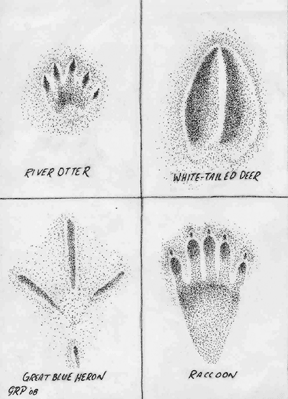|
|
|
||||||||||
|
|||||||||||
|
|||||||||||
We Are Not Alone
|
|||||||||||
Common name: River OtterScientific name: Lutra canadensisWhat to look for: Shallow prints, roughly circular, 11⁄2 inches long with 5 toes.What to bring: Peterson Guide to Animal Tracks by Olaus Murie.Where to look: Beaches, muddy creek banks, snowy ground.Places to go: Bayside Park (Brownies Beach), Chesapeake Beach. Fort Smallwood Park, Pasadena. |
Raccoon, deer and great blue heron, too, had walked the beach that morning or the day before. The sand said so.
Beaches, snow-covered ground and muddy stream banks are good places to look for animal tracks.
With my camera, I captured an image of the otter prints. At home I compared my digital images to Olaus Murie’s elegant pen-and-ink drawings in the Peterson Field Guide to Animal Tracks, published in 1954. I was delighted to see the legendary naturalist rendered a close match to the early 21st century prints I captured digitally.
Murie explains how to be a wildlife detective, advising on how to read and interpret the marks that animals leave behind: not just tracks on the ground but also signs such as claw marks on trees and tooth marks on twigs. He devotes lots of text and illustrations to scat.
Westmoreland State Park on the Potomac in Virginia was the setting for my recent otter sighting. With its high cliffs loaded with Miocene marine fossils, it is remarkably similar to many places along Calvert County’s Chesapeake shoreline. Anne Arundel County has no shortage of sandy shoreline good for finding animal tracks, either.
Take along your camera and a copy of Murie’s Guide. Or be like Murie and bring your sketch book to record your findings. You can go one step further if you follow the author’s instructions on making plaster casts of animal tracks; it’s easy and fun.
|
Current Issue \\ Archives \\ Subscriptions \\ Clasified Advertising \\ Display Advertising |
© COPYRIGHT 2008 by New Bay Enterprises, Inc. All rights reserved.


